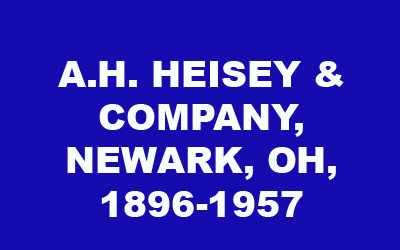|
Heisey Company History

| Heisey Company History |
Heisey (A. H.) and Company, Newark, Ohio (1896-1957).
By the time this company began operations in 1896, Augustus H. Heisey was already a veteran in the field of glassware. After an early experience working for the King Glass Company, he joined the Ripley Glass Company, where he gained a reputation as one of the best salesmen on the road. In 1870, he married Susan Duncan, daughter of George Duncan, who eventually took control of the Ripley factory. It was renamed Geo. Duncan & Sons, with son-in-law Augustus Heisey as one of the partners. After the Duncan plant became part of the United States Glass Company in 1891, Augustus Heisey became general manager of the commercial department of the new combine. However, it appears that U.S. Glass was top-heavy with managers or that Heisey was unhappy as a member of such a large conglomerate. Quite possibly it was a combination of these two factors, since U.S. Glass let a number of other managers go within a few years of its formation and, by 1893, Heisey seems to have been among those who had severed their connections with the company. He began looking for a site for a new factory of his own and settled on Newark, where construction began in 1895. After a number of delays, glass was made for the first time in April 1896. Always an astute businessman, Heisey made sure that his first two new patterns were on display at the annual trade show in Pittsburgh earlier that same year by taking the molds down the road to the Robinson Glass Company in Zanesville, Ohio, and having samples made there.
From the very beginning, Heisey concentrated on making high quality crystal, with many of the initial patterns being imitations of cut glass. The company's reputation was really established in 1899 when they brought out their No. 300 Peerless line, a colonial pattern that Crockery and Glass Journal stated "only a metal maker capable of producing pure, fine crystal would be bold enough to adopt." Although at least one other company had produced a paneled pattern a year prior to Heisey (the Riverside Glass Works' X Ray pattern), there is no doubt that the tremendous popularity of the No. 300 line was the beginning of what was to become a renaissance in colonial patterns. Within the next couple of years virtually every other major glass manufacturer introduced similar lines, and Heisey was to continue offering one or more colonial patterns throughout the remainder of their history.
Another innovation was the introduction of the Diamond H trademark in 1900. Heisey was one of the few companies to routinely impress their trademark in their glassware, a factor that has contributed greatly to making Heisey as collectible as it is today. Although the company was later to advertise that every piece was marked with the Diamond H, in some cases this referred to the use of a paper label. Nevertheless, a larger proportion of Heisey's ware was marked than is true of any other manufacturer.
Heisey also pioneered in the use of advertisements in popular magazines like House and Garden, The Woman's Home Companion, and others, beginning as early as 1910. Prior to that only one or two cut glass companies had explored this avenue for gaining name recognition. Once again, Heisey was in the vanguard with most other pressed glass manufacturers soon following suit.
1914 brought the addition of blown ware, followed by an increase in the use of various decorating techniques, such as etching and cutting.
Augustus Heisey died in 1922, with the presidency of the factory passing to his son, E. Wilson Heisey. The bulk of color production occurred between 1925 and 1939. Some of the patterns most popular with collectors today also date from this period, including Empress, Old Colony, Ipswich, Saturn, Ridgeleigh, Crystolite, and Queen Ann - a mixture of traditional designs, Sandwich reproductions, and art deco.
E. Wilson Heisey died in 1942 and was replaced by his brother, T. Clarence Heisey. The forties saw the introduction of most of the animal figurines, many designed by Royal Hickman, that are so highly sought after today. Late patterns from the 1940s and 1950s included Lariat, Plantation, Old Williamsburg, and Cabochon. However, despite occasional successes, the 1950s were a time of struggle for the factory, with American handmade glassware in general vying against imported glassware, machine made domestic glass, and the growing plastics industry. Heisey investigated a number of schemes for revitalizing the factory, including moving to the manufacture of optical glassware, but none of them were realistic, probably due to the capital expense that would have been involved. So it was in December 1957 they closed for the traditional Christmas vacation and never reopened.
In April 1958, the Imperial Glass Corporation bought all of the molds, etching plates, patents, trademarks, and batch formulas. By July, Imperial had begun advertising "Heisey by Imperial" with the slogan, "Two good names are better than one." They continued to make pieces from the Heisey molds until their own closing in 1984. At that time, the Heisey Collectors of America, the national club located in Newark, Ohio, was successful in purchasing all of the molds except those belonging to the Old Williamsburg pattern, which were acquired by the Lancaster Colony Corporation. Most of the molds from the early years were destroyed long before Heisey went out of business (many of them during World War II when scrap metal was in high demand).
? Adapted from The Glass Candlestick Book, volume 2, by Tom Felt, Rich & Elaine Stoer (reprinted with permission) |
| Keywords: |
|
| Date: |
28.04.2007 21:49 |
| Hits: |
2975 |
| Added by: |
Tom Felt |
|
|

Powered by 4images 1.9
Copyright © 2002-2024 4homepages.de
Copyright © 2003 - 2019 Glass Etch and Pattern Gallery. All rights reserved, foreign and domestic.
|

